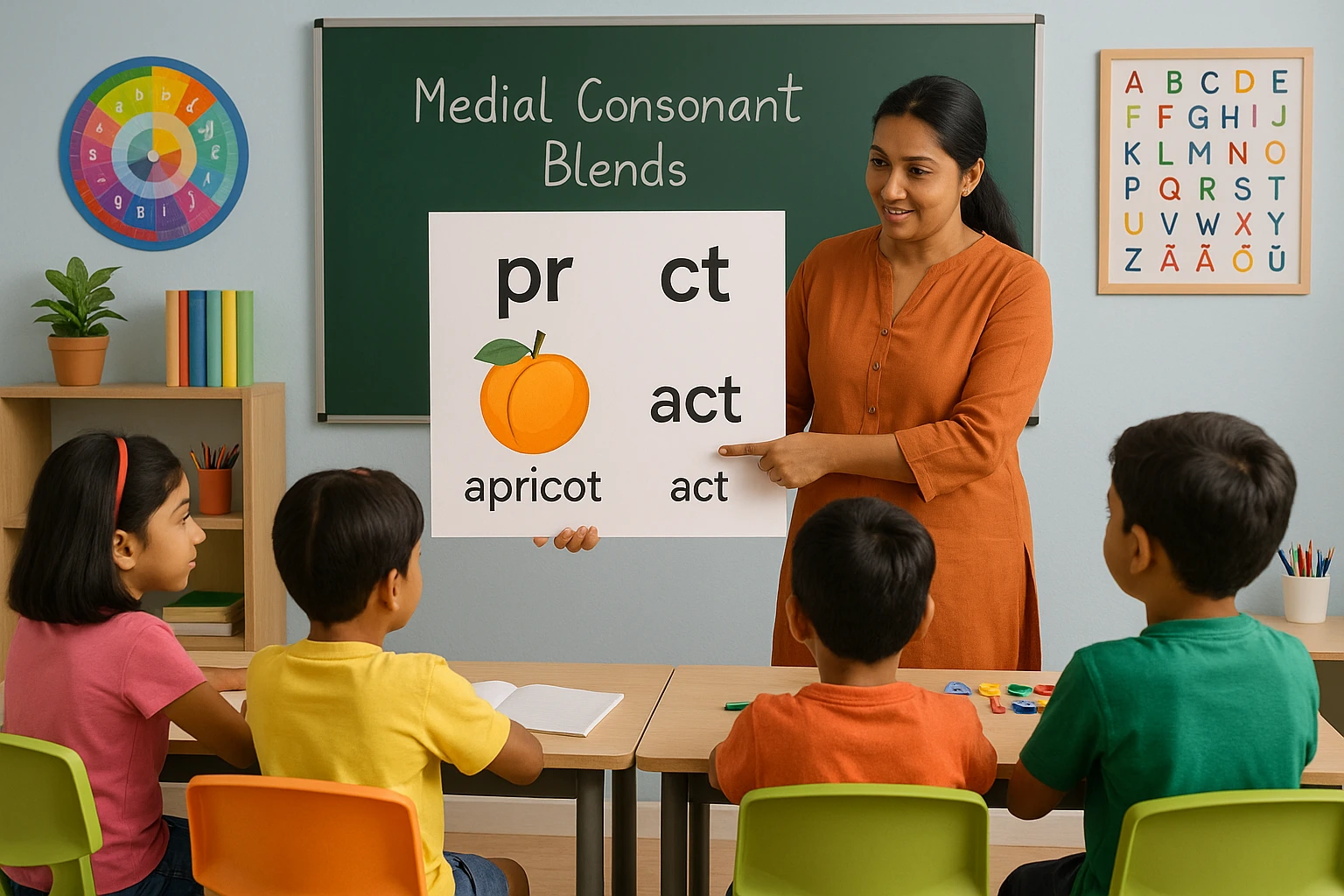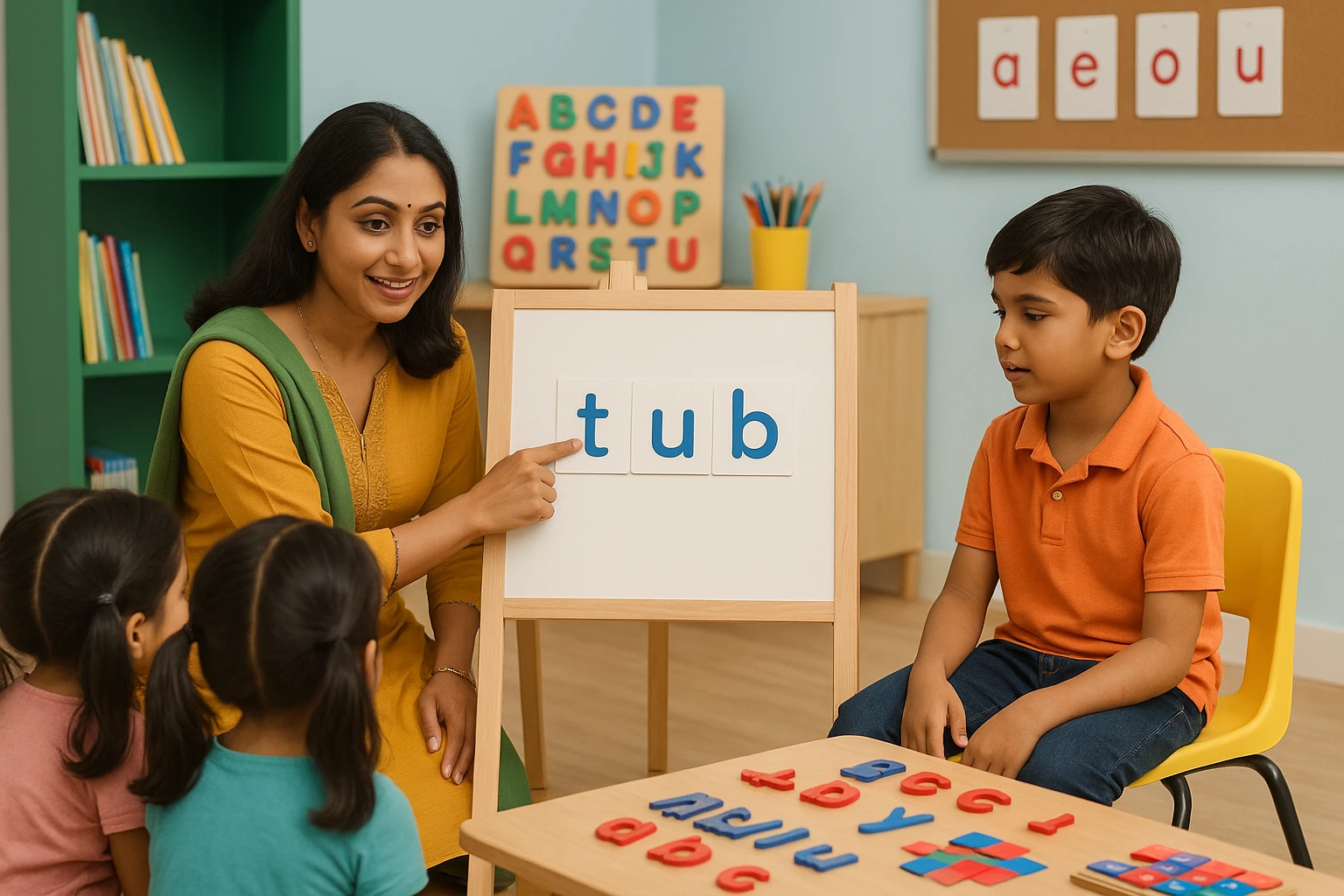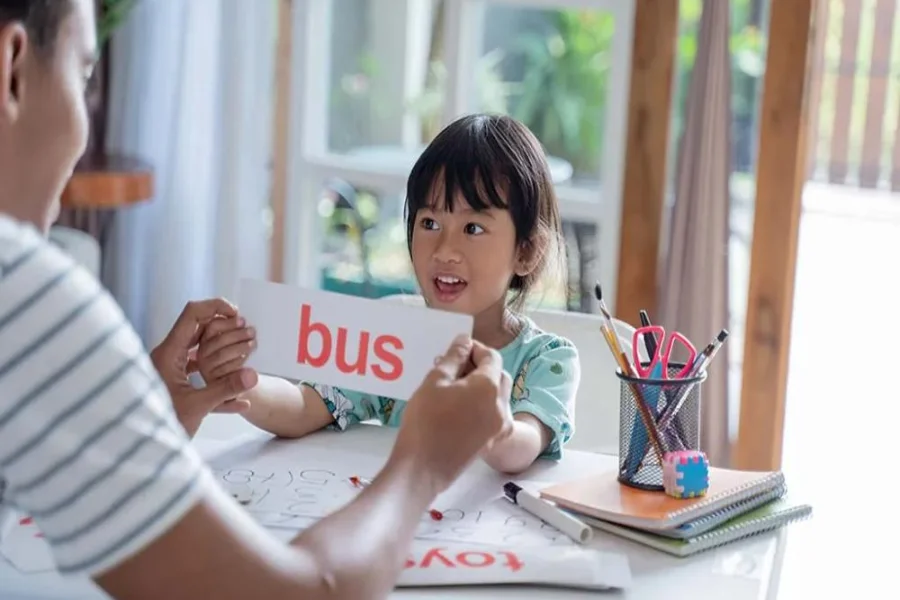What are the Different Types of Phonics Blends?
What are the Different Types of Phonics Blends?
A group of two or more consonants where respective sounds are heard is termed a Phonics Blend. For example- bl, st, gr, etc. These help children connect letters and sounds, making reading and spelling fluent.
A significant part of early reading and spelling development is identifying the Different Types of Phonics Blends present in words. Mastering these blends builds a robust base for eloquent reading habits.
Table of Content
Why Teach Blending?
Blending is an integral Part of Early Reading Mastery. It helps children discover how words are formed from unique sounds. This technique is particularly effective when used with blends. Concentrating on blends builds a robust basis for mastery and comprehension.
For downloading the brochure of Phonics Course, Click Here!
Call or Whatsapp on +918104606573 / +919869866277, for more details of Phonics Course!
Why Teach Blending to Children:
- Supports Word Recognition: The blends helps in acknowledging patterns in words. This allows children to decode new vocabulary more efficiently and read with confidence.
- Improves Spelling Skills: An understanding of the blends helps children spell words accurately, making writing assignments less complicated.
- Increases Reading Mastery: The blends allows smoother shifts between letters, which boosts overall reading mastery and speed.
- Builds Listening and Sound Discrimination: The blends make listening, identifying, and using sounds easier—fundamental elements in phonemic understanding.
Teaching Phonics with the help of the blends turns early readers into self-reliant learners.

What are the Different Types of Blending in Phonics?
Mastering Different Types of Blending in Phonics helps children interpret words smoothly and build more robust reading skills.
Below are the Different Types of Blending in Phonics explained in detail:
Initial Consonant Blends
- These appear at the start of words. They incorporate two or more consonants that are grouped together, wherein each sound stays distinguishable.
- Examples: bl- blow, st- step, tr- tree
- Children learn to say both consonants quickly together, thus helping them recognize the word beginning.
Final Consonant Blends
- These appear at the end of words and are composed of two consonants. Each sound is enunciated closely together, though heard distinctly.
- Examples: nd- sand, mp- lamp, sk- husk
- An understanding of these blends helps improve spelling and word endings.
Medial Consonant Blends
- These blends appear in the middle of words, combining two consonants that flow together.
- Examples: pr- apricot or ct- act
- Acknowledging these blends helps in deciphering multisyllabic words.
Three-Letter Blends
- These are more progressive blends that comprise three consonants, usually at the start of a word.
- Examples: spr- spring, spl- splash, thr-three
- Learning how to read and enunciate three-letter blends promotes reading mastery and expands vocabulary.
Word Blending
- This approach involves blending respective sounds together to form a whole word.
- Example: j-u-g becomes jug
- It’s a core technique in early Phonics Blends instruction that builds basic reading skills.
Children gain confidence in reading, spelling, and comprehending new words effectively with the routine practice of these blends.

What are the Different Methods of Blending?
Blending is a vital skill in early reading improvement. It involves merging individual letter sounds to read words. In phonics teaching, this process is usually introduced using blends, which are distinct combinations of letters that lead to smooth and eloquent reading. Understanding the Different Methods of Blending helps children interpret unknown words and develop reading mastery.
Below are the most standard approaches:
Sound-by-Sound Blending
- This approach prepares children to articulate each sound in a word and then slowly blend them.
- Example: For the word- tub, the child says /t/… /u/… /b/, then places them together to read- tub.
- This approach supports sound recognition and is widely used when familiarizing blends for the first time.
Continuous Blending
- In this method, children hold each sound slightly longer and blend as they go without pausing.
- Example: Rather than isolating each sound, the child says- ccccaaaat.
- It functions well for words that use smooth blends, such as sl, br, or gl.
Final Blending
- Here, children preferably blend the initial sounds, then add the final sound.
- Example: For- sun, blend /s/ and /u/ to make- su, then add /n/ to form- sun.
- This method is specifically useful for reading blends that occur at the start of words.
Successive Blending
- This approach creates the word progressively by adding one sound at a time.
- Example: Begin with /s/, then /su/, and eventually /sun/.
- It helps children split longer words with numerous blends.
Each of these methods supports reading advancement in remarkable ways. Diverse blending strategies help children tackle a wide range of blends confidently and develop robust reading skills.

Source: firstcry.com
How do you Teach Phonics Blends?
Phonics Blends are sets of two or more consonants where each sound is heard. These sounds occur at the start or end of words and need observant practice for children to identify and enunciate correctly.
The Phonics Teacher Training Course presented by Vidhyanidhi Education Society (Govt. Regd.) provides step-by-step guidance on how to teach these blends effectively.
Here’s how to Teach Phonics Blends systematically:
Start with Consonant Blends
Begin with basic two-letter blends like bl, cl, tr, and gr. Use visual resources to help children acknowledge and repeat the sounds. The Phonics Teacher Training Course accentuates the gradual introduction of blends to avoid confusing learners.
Sound Seclusion and Blending
Familiarize children with first splitting each sound in the blend. For instance, in ‘from’, enunciate /f/ and /r/ separately, then blend them smoothly. Consistent oral practice supports pronunciation and fluency.
Word Building Activities
Let children create new words utilizing the blend sounds. Activities like word spins, blend riddles, and spelling mats help them associate blends with vocabulary advancement.
Reading Practice with Blends
Provide brief reading paragraphs or word lists concentrating on distinct blends. Reading aloud helps strengthen the sound patterns and boosts confidence.
Engaging Visuals and Games
The use of vocals, phonics contests, and accounts containing blends can make learning more interesting. The Phonics Teacher Training Course by Vidhyanidhi Education Society (Govt. Regd.) includes numerous such tactics tailored for diverse learning styles.
Using methodical approaches from a trusted source like the Phonics Teacher Training Course guarantees that educators are well-prepared to build a robust foundation in blends for young learners.
Master Phonics Blends with ease—join Vidhyanidhi’s Phonics Course today!
For downloading the brochure of Phonics Course, Click Here!
Call or Whatsapp on +918104606573 / +919869866277, for more details of Phonics Course!
FAQs
What Order to Teach Blends?
Begin with easy two-letter blends, then proceed to more intricate blends after grasping the basics.
What is the Rule for Blends?
In blends, each consonant keeps its sound and is heard when spoken, unlike digraphs, where two letters make one sound.





